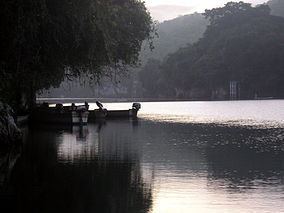Location Cagayan, Philippines Nearest city Tuguegarao | Area 1,188 km² | |
 | ||
Established July 16, 1935 (National park)
July 8, 1940 (Forest reserve)
June 29, 1994 (Protected landscape)
October 6, 2003 (Protected landscape/seascape) Governing body Department of Environment and Natural Resources Management Department of Environment and Natural Resources | ||
The Peñablanca Protected Landscape and Seascape, formerly the Callao Cave National Park, is the largest protected area in the province of Cagayan in northern Philippines. It is on the border with Isabela province, contiguous with the Northern Sierra Madre Natural Park. The protected area, best known as the location of Callao Cave, covers the largest block of forest under conservation in the province. It is located in the municipality of Peñablanca and covers 118,781.582 hectares (293,515.68 acres) of the northern Sierra Madre mountain range and its adjacent Pacific coast.
Contents
Description
The Peñablanca park is situated just 24 kilometres (15 mi) east of Cagayan's provincial capital of Tuguegarao and some 580 kilometres (360 mi) north of Manila. It extends along the northern Sierra Madre range from the Twin Peaks south to Mount Cetaceo towards the border with Isabela. It covers 18 of the 24 barangays of Peñablanca, namely, Callao, San Roque, Cabbo, Nannarian, Malibagbag, Quibal, Agugaddan, Lapi, Nanguilattan, Nabbabalayan, Buyon, Mangga, Minanga, Sisim, Bugatay, Bical, Baliuag and Cabasan.
The park is well known for its numerous limestone formations found within its 300 cave systems, the most popular of which are Callao Cave and Sierra Cave. It is traversed by the Pinacanauan River, a major tributary of the Rio Grande de Cagayan, which supplies clean water and irrigation to surrounding communities as well as the nearby city of Tuguegarao. The park is inhabited by three indigenous groups, namely the Ibanag, Itawes and Aeta. It is also known for its archaeological relics discovered within its caves.
Activities within the park include hiking, spelunking, fishing, swimming, and other water activities. Near the entrance to Callao Cave is the Callao Park and Resort, developed and maintained by the Cagayan Provincial Government, which has several cottages, a two-storey hotel, a multi-purpose pavilion, viewing deck and picnic tables.
Biodiversity
The Peñablanca park has a total 34,380.9 hectares (84,957 acres) of old growth forest, 14,890.4 hectares (36,795 acres) of secondary forest and 6,122.9 hectares (15,130 acres) of mossy forest. It supports a variety of wildlife, including the endangered Philippine Eagle. Along the park's Pacific coastline are several blocks of undisturbed mangroves and rich coral reef system.
As a key biodiversity area, the park is home to several other threatened and restricted-range birds such as the flame-breasted fruit dove, spotted imperial pigeon, Isabela oriole, green racquet-tail, Philippine eagle-owl, whiskered pitta, Philippine duck, celestial monarch, Luzon water-redstart, ashy-breasted flycatcher, and green-faced parrotfinch. Non-bird population includes the Philippine deer, Philippine crocodile, Malay civet cat, Sierra Madre shrew-mouse, Luzon pygmy fruit bat, and Northern Luzon cloud rat.
The park's forest cover is composed of Dipterocarp trees such as narra, molave, agosip, ipil-ipil, balete, tindalo and anabiong.
